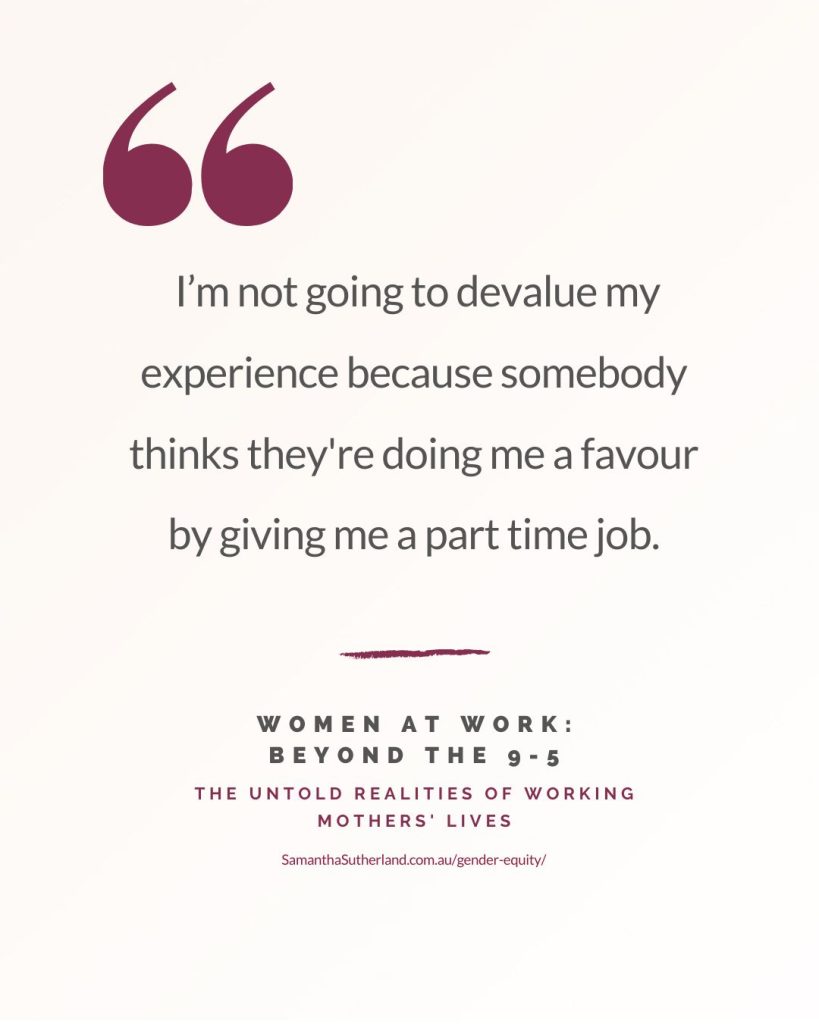Women at work, beyond the 9 to 5: The untold realities of working mothers’ lives.
Naomi* has 2 girls aged 7 and 9, lives with her husband and is job hunting – looking for meaningful, part time work. We chatted about the huge untapped resource of working mothers, and the barriers she has faced finding opportunities.

Sidelining part time workers
After 10 years with the same organisation, and a job that ramped up hugely during COVID whilst homeschooling two girls then in kindergarten and a year 2, Naomi was completely burned out. After taking some time out, she’s looking for work that has the flexibility to fit around her family.
“I’m really focused on something that has true flexibility. There is hardly anything that is advertised as part time. When you do talk to people who say they can do part time, they mean four days a week. But there’s no change to the job, it just means get all your work done in four days, instead of five, and we’ll pay you less money.”
“Then there’s this attitude that it’s part time, so we’re not going to pay much, or it’s going to be positioned as more junior. It’s difficult to find something that is meaningful and reflective of the experience I’ve got, but that still allows me to have true flexibility so that I can be there for my family.”
In conversation with a recruiter about wanting part time, they said, ‘well you’ve got to earn that in an organisation’. But with 20 years of work experience, and proving she can perform in myriad different formats, Naomi has already earned her right to work part time. She also pointed out that with people globally working remotely and flexibly, productivity and only increase. Add to that, working mothers are the most efficient people in the workforce.
“I’ve worked my a** off for however many years. I’ve worked part time, I’ve worked job share, but I’ve always worked more hours than what I’ve been paid for. That’s been my choice, I could have gone full time, but part time is what has worked for my family. So now, I’m not going to devalue the experience that I’ve got because somebody thinks they’re doing me a favour by giving me a job. [Saying I had to earn it] made me really bristle. It’s an archaic viewpoint. But it’s still out there, that’s the thing.”
The cost of care
Naomi shared the common expectation that when kids reach school age, things get easier. But school brings shorter hours, after school activities, a juggle of after school care, and new challenges navigating friendships and homework.
“There is just so much stuff to do with the kids!”
“The cost of childcare in Australia, at daycare centres and also nannies, is just prohibitively expensive. It’s an insane amount of money, where sometimes you would think, ‘Why am I working so hard? When this is what I’m bringing home after we’ve paid for childcare?’.”
She clarified that childcare is a family cost, not a cost to be borne by the mother’s salary. It’s the only household cost that people systematically attribute it to one person’s income.
Missing out on our economic superpower
“There are so many women out there who are not in the workforce who would like to be, but would like to work not full time hours. And it is made so difficult. That untapped workforce of women would be some of the most productive people out there!”
The Grattan Institute research showed that with six per cent more women in the workforce Australia’s GDP would be $25 billion higher. Without enabling interest work available through creative job design, companies are missing out on high financial benefits.
Arup Australasia’s CEOs are Kerryn Cocker and Kate West, two formidable women who are job sharing. Job sharing is one way to get mothers into meaningful roles while maintaining caring responsibilities – both Cocker and West are mothers to primary aged children.
Naomi has job shared in the past before. It was supported by her senior leader, but she still faced challenges.
“I had to build a business case, and the senior leader was kind of like, ‘What are you talking about?’. It was very much considered a trial, not, ‘Wow, this is amazing. We’re getting two great women”. If you get the right people together, it’s not difficult to manage. It’s a good solution, but you don’t see very much of it at all.”
Building a culture where everyone can thrive
Shifting a culture to enable meaningful part time work, ensure women aren’t sidelined if they have a family, and where you get the full value of your diverse and experienced workforce, takes time and investment.
Find out more about how I can help here.
*Not her real name. Because of the stigma faced by working mothers, the motherhood penalty, and the fact that the state of women’s relationships directly affects the state of their lives and careers, the women in this series have chosen to remain anonymous.
If you would like to share your story, please send me a message!
